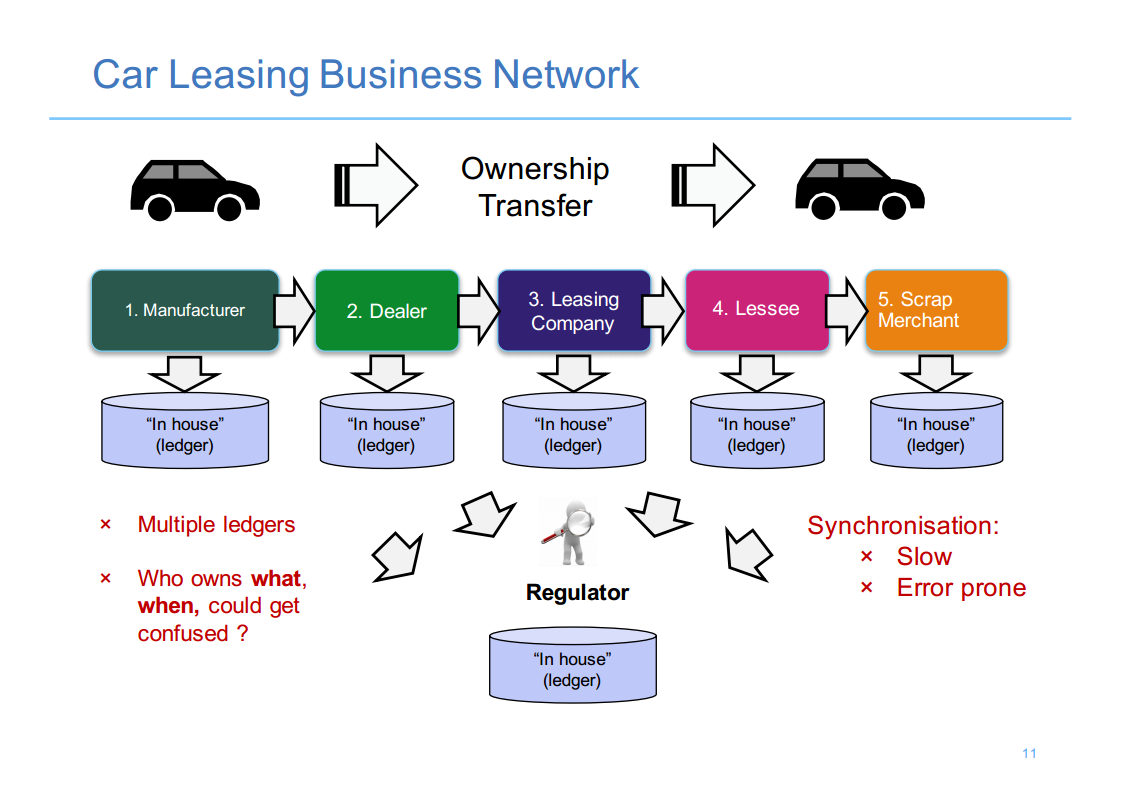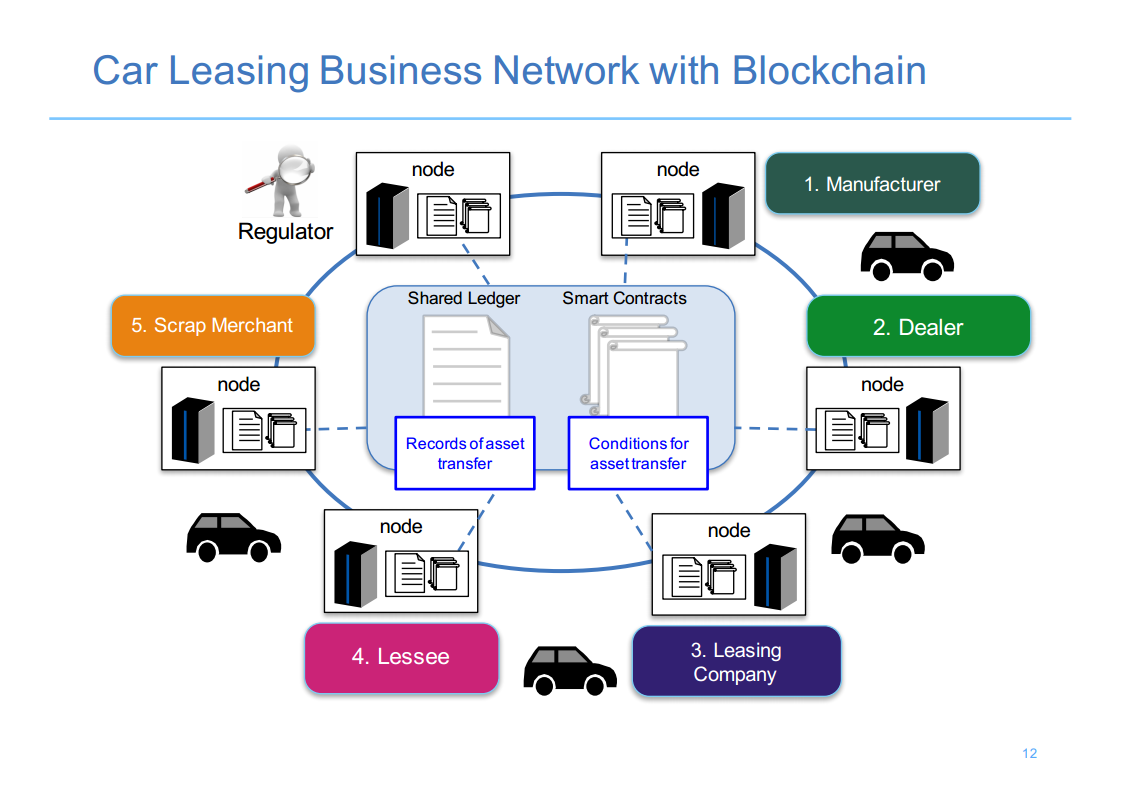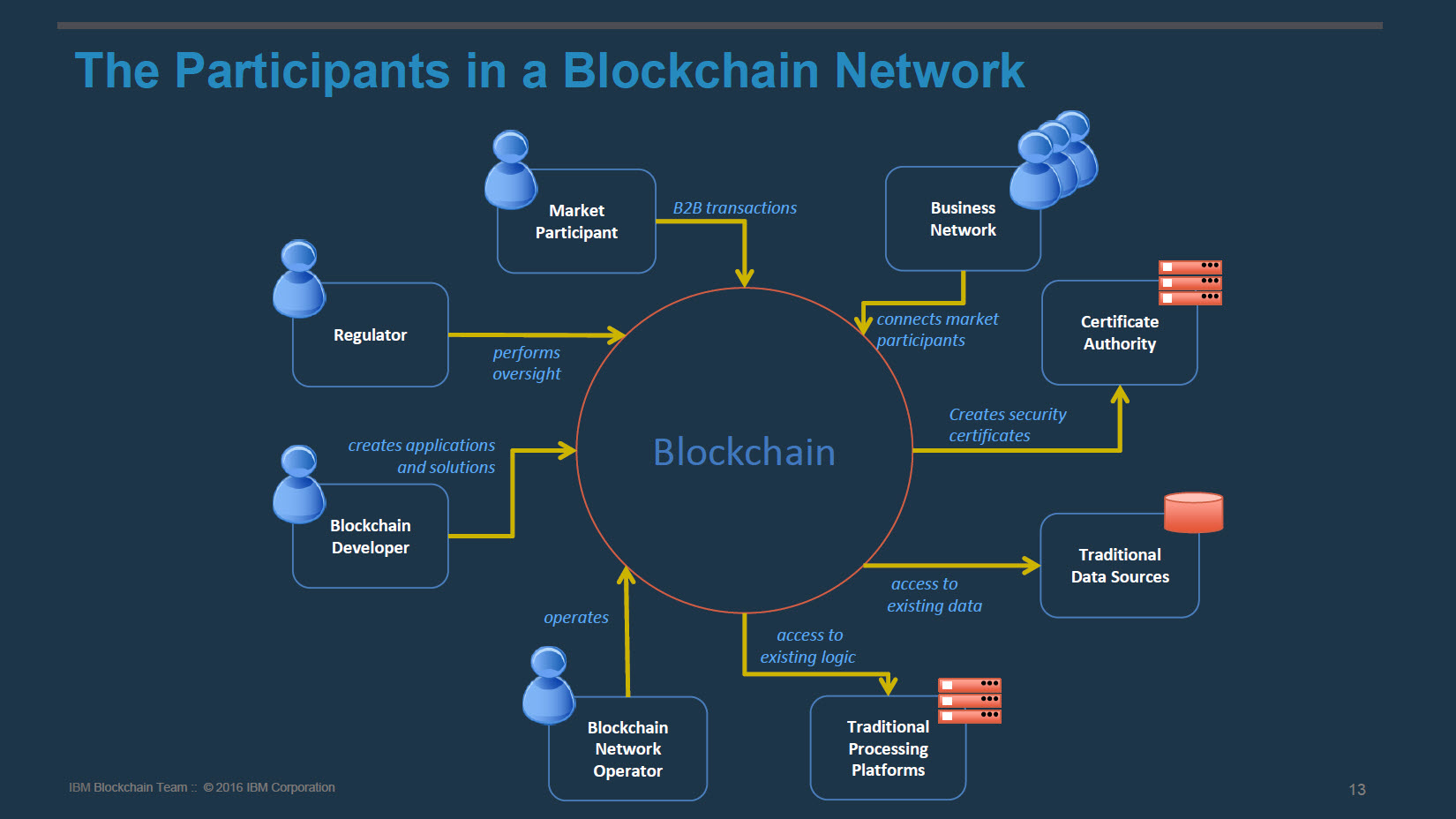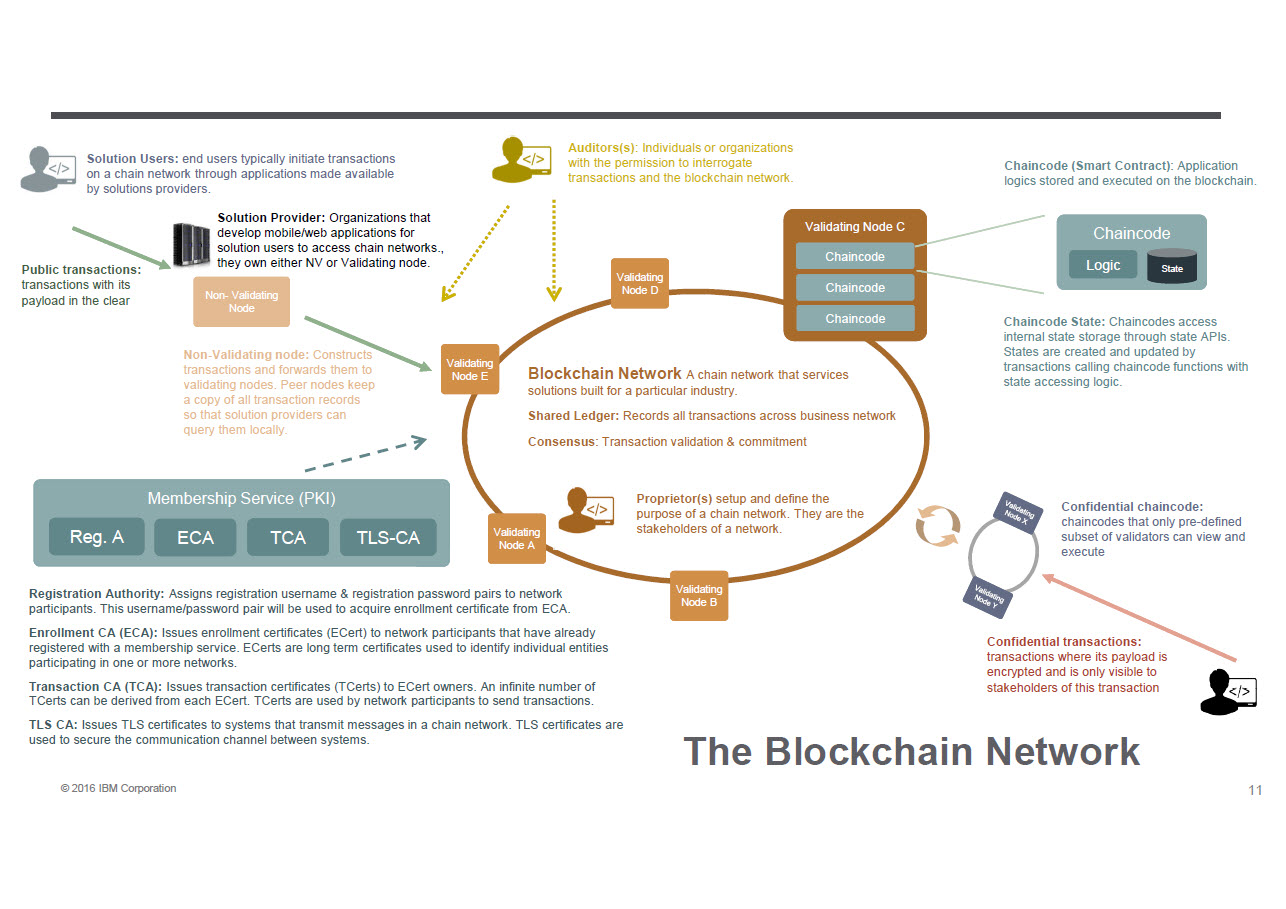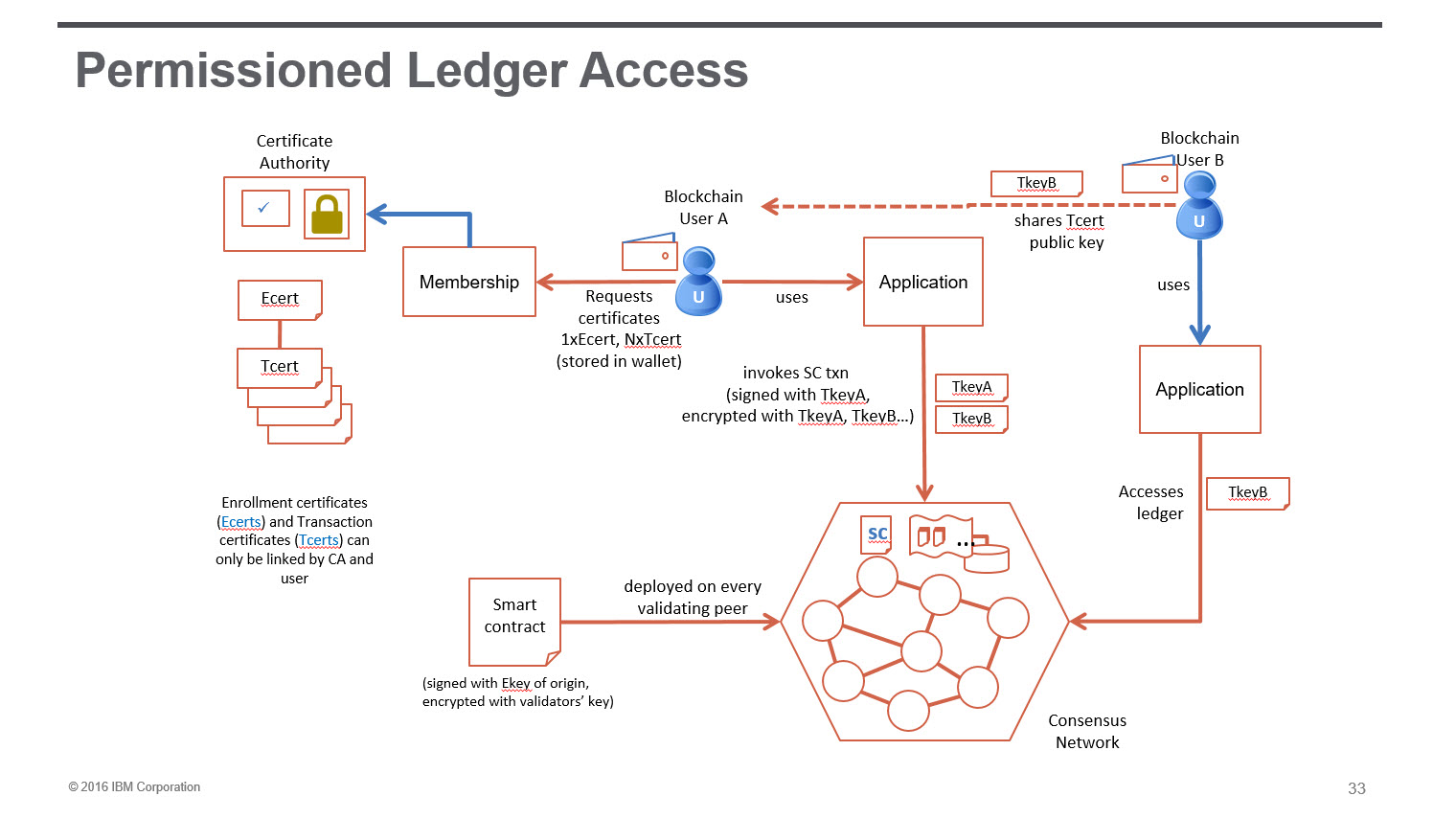A Distributed Business Network: The Difference with Blockchain
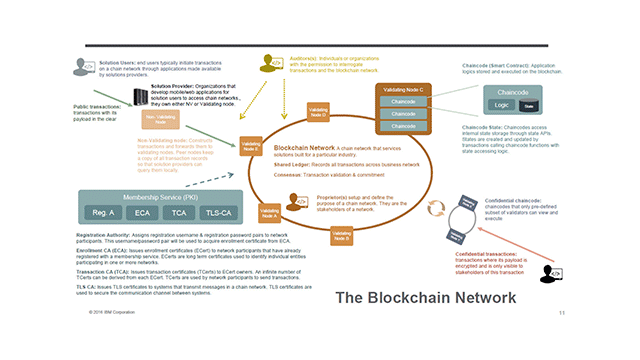
With and without blockchain
Thanks to blockchain picking up steam the past few months, here at Altoros, we’ve covered a lot about the role and future of distributed technologies such as Hyperledger and Ethereum. This time, we take on a different angle with blockchain, figuring out how it makes a difference in a business network and how that network would look like.
Some time ago, Anthony O’Dowd gave a technical session at IBM InterConnect, showing the difference blockchain would make on a car leasing network.
Without blockchain, this is how the business network would look like:
In this traditional scenario, we can already see some potential problems:
- Multiple ledgers. With multiple ledgers, it gets difficult to figure out who owns what and when ownership gets transferred.
- Slow updates. Since each participant in the network has its own ledger, synchronization isn’t achievable real time.
- Error-prone updates. Without having smart contracts, each participant relies on its own business processes to update the ledger. Having no central authority, this could lead to errors.
With blockchain involved, this is how the network would look like:
The car leasing network gets some benefits with blockchain:
- Shared ledger. The ledger is now an append-only distributed system of record shared across all participants in the business network.
- Smart contracts. Smart contracts are business terms embedded in transaction databases and executed with transactions.
- Permissions. Viewing permissions are defined for each participant in the business network to ensure privacy.
- Consensus. All participants in the business network agree to network verified transactions.
- Efficiency. Transaction times and data synchronization is reduced from days to near real time. Overhead and intermediary cost reductions.
- Reduced risk. Risk of tampering and fraud is reduced with transaction certifications and signatures.
Who are the participants in a blockchain?
Now that we’ve seen how blockchain makes a difference in a traditional business, let’s take a closer look at all the participants in a blockchain network and how it is run.
Each participant in a blockchain network has its own purpose:
- Regulator. The regulator performs oversight for the blockchain network and usually has permission to see all transactions that occur within the network.
- Market participant. The business user, operating in a business network. This role interacts with the blockchain network using a line of business application. They are not aware of blockchain.
- Business network. The business network simply connects market participants in the network.
- Certificate authority. The certificate authority creates security certificates and provides privacy and cryptography within the network.
- Blockchain developer. The blockchain developer creates applications and solutions, which include smart contracts.
- Blockchain network operator. Simply put, this participant, defines, creates, manages, and monitors the blockchain network. Each business in the network has a blockchain network operator.
- Traditional processing platforms. This participant is an existing computer system which may be used by the blockchain network to augment processing. This system may also need to initiate requests into blockchain.
- Traditional data sources. This participant is an existing data system which may provide data to influence the behavior of smart contracts.
For a more technical explanation of how the blockchain network operates, refer to the following diagram:
“Privacy is very important here and at the heart of that privacy is cryptography.”
—Anthony O’Dowd, IBM
Permission through certificates
Permissioned ledger access is one of the key things that define blockchain. This next slide shows how blockchain provides it:
There’s a lot going on here, but permissioned access essentially boils down to these things:
- Transaction certificate (Tcert) and enrollment certificate (Ecert)
- Tcerts are disposable certificates, typically used once. These are requested from the Transaction Certificate Authority.
- Tcerts are derived from long-term identity Ecerts.
- Only the Transaction Certificate Authority in the blockchain network can link Ecerts and Tcerts.
- Permissioned interactions
- A market consumer shares public Tcert to a market provider.
- A market provider invokes smart contracts, but signs with the provider’s private Tcert for authentication and encrypts with provider and consumer Tcerts for subsequent access.
- Market consumers can subsequently access ledger data using their private key.
- Smart contracts
- Smart contracts can be signed and encrypted to verify and secure contract details.
- Signing is by a contract owner/author.
- Encryption ensures only validators can see and execute smart contracts.
“Permissioned ledger access is all about transaction identity privacy.” —Anthony O’Dowd
What’s the big difference?
We can already see the potential this technology can do for business networks. With blockchain, you get smart contracts, shared ledgers, permissioned access, and secure and efficient transactions among other things. When it comes down to the wire, having blockchain in the network adds one very important element that makes all the difference—trust.
Lena Glyptis of Sapient Global Markets described it best when she said, “The blockchain technology represents (an approach) that fundamentally redefines our value chain.”
For more, check out another Anthony’s technical introduction to Hyperledger he presented recently.
Want details? Watch the video!
Table of contents
https://youtube.com/watch?v=Ko9MDxmGoAg |
Related slides
Further reading
- Blockchain as a Single, Persistent Publish / Subscribe Queue
- When Will Blockchain Be Massively Adopted and How to Boost the Process?
- Managing Risk and Building Trust for Blockchain in Finance
- Blockchain Adoption: Industry Requirements and the Role of Prototypes




